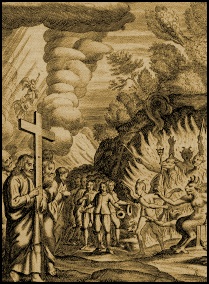Make no joke about it: the devil exists, people do evil things. Of course, the existence of the devil is not at all the same as we seen in the movies. We know this is a fact from our personal experience and from the Gospels: the devil works on believers to get them away from adhering to Jesus Christ. We don’t fool around with the devil and his temptations, nor his ability to possess a person. So, ridicule would not be the correct approach to understanding the nature of the devil and demonic possession. While believers say that evil is real, it is our unqualified belief that evil and the devil are powerless to the power of Jesus Christ, the eternal Son of God, the Second Person of the Blessed Trinity. It is Jesus who expels the devil, not the priest. Evil is terminated only through prayer, fasting, the sacraments; when it is discerned by competent authority, the praying of the Rite of Exorcism may be done. The Rite is performed only by a validly ordained Catholic priest who is deputed by the bishop of the diocese in which the priest lives, and who is known to live a life of virtue and sanctity.
 The Church protects the exercise of the Rite of Exorcism in the Code of Canon Law (1983) by saying, “No one can perform exorcisms legitimately upon the possessed unless he has obtained special and express permission from the local ordinary. The local ordinary is to give this permission only to a prebyter who has piety, knowledge, prudence and intergrity of life (1172).
The Church protects the exercise of the Rite of Exorcism in the Code of Canon Law (1983) by saying, “No one can perform exorcisms legitimately upon the possessed unless he has obtained special and express permission from the local ordinary. The local ordinary is to give this permission only to a prebyter who has piety, knowledge, prudence and intergrity of life (1172).
The awareness of evil in the world is increasing with the desire of the Church to find competent priests and bishops –not every priest and bishop have the qualifications to do an exorcism– i.e., some are incapable of doing the Rite of Exorcism.
“Anyone who does not believe in the Devil does not believe in the Gospel,” Pope John Paul II. Catholics hold that the Lord gave the power to cast out demons to the Church (cf. Mark 16:17).
A recent story dealing with the training of exorcists today. The Catholic bishop of Sprinfiield in Illinois and canonist, Bishop Thomas Paprocki organized a meeting of priests and bishops to orient them with the 1999 revision De Exorcismis et Supplicationibus Quibusdam (On Exorcism and Certain Supplications). The purpose is to gain the proper skills to correctly discern the need to use the Rite of Exorcism. Its use is infrequent but sometimes necessary.
Some critics suggest this type of meeting is playing into a “reversion” to prior times, playing on the fears of the weak. What Bishop Paprocki did is to provide some members of the clergy the tools, theology and expertise, training and insight into knowing more about matters transcendent.
I have heard from priest friends that the old rites of baptism and exorcism are stronger in getting rid of the devil than the newer ones. You may want to read this article, “The New Rite of Exorcism, The Influence of the Evil One.”

